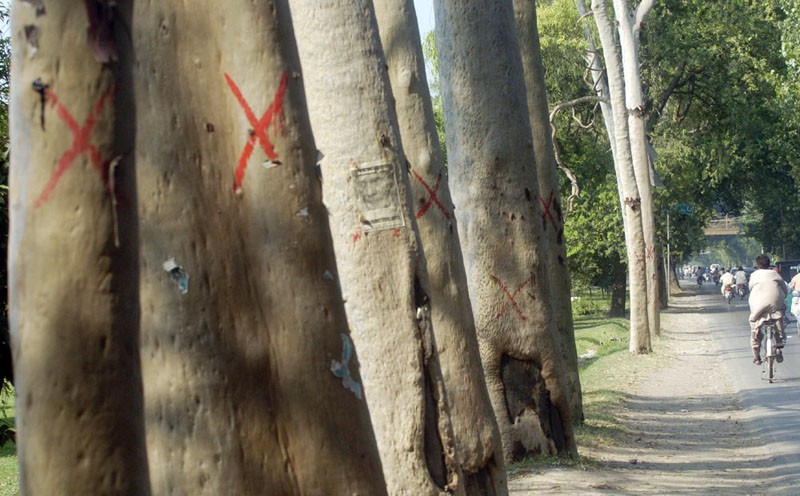
Ongoing work on the much-tomtommed signal free corridor has stripped the Main Blvd and Jail Road of green belts, besides some of Lahore’s oldest trees. The PHA has promised to return the city to its green glory. But will it?

The Parks and Horticulture Authority (PHA) of Lahore recently announced one of their most coveted projects -- plantation of 1000-odd trees along the signal free corridor. Evidently, it has met with mixed reviews.
As the story goes, the construction work for the 7-km long signal free corridor, which began in July 2015, has resulted in the depletion of several green belts that also included some of Lahore’s oldest trees. In order to return the city to its green glory, while also retaining the myriad road construction projects, the PHA was commissioned the task. They are supposed to start with two of the city’s busiest routes -- Jail Road and Main Boulevard.
Director General PHA Shakeel Ahmed claims that as many as "290 trees have been removed [so far] for construction purposes." He says "the project of signal free corridor is ‘owned’ by the Lahore Development Authority [LDA]; PHA’s responsibility is only to beautify the city."
According to reports, the plantation work shall commence as soon as LDA clears the area. "The work shall be completed in parts," Ahmed adds. "The Authority will need to get clearance from LDA to carry out the task it has been assigned."
He also says PHA shall be planting 600 trees on Jail Road alone, thereby increasing the amount of green space along the signal free corridor.
However, he admits that the newer green patches cannot become a reality overnight. "The landscaping will show rapid outcomes in the form of flower plantation on roundabouts and U-turns. Planting trees, on the other hand, does not guarantee immediate results. The trees will take about a year to fully thrive."
The trees to be planted would not come in form saplings, as dreaded. On the contrary, they would be "half grown" (in DG PHA’s words) and only need to be replanted.
Speaking to TNS, the Range Foresting officer Arooj Imdad says, "Areas that are already covered with plantation such as green belts would quickly rejuvenate once replantation is complete."
The soil, Imdad says, "does not lose its vitality. The plantation which was there before has enriched the area enough to bear a new inclusion."
Sustainability puts as a major question mark on the proposed work. The clash of revenue spending and unnecessary visual improvement is at the core of most works of the PHA. There have been instances when the planted trees were not of species indigenous to Lahore. The date trees, planted on the Circular Road green belt, are an example. Eventually, the trees were uprooted.
There is a clear dichotomy between the responsibilities of the Department of Horticulture. The Authority, on the one hand, needs to create a façade of beauty and, on the other, it needs to ensure ‘usefulness’ of its plantations. PHA’s focus is to enhance the aesthetic appearance of the city any way. Ensuring the environmental sustenance is also significant.
"Amaltas (Cassia Fistula) and Legestonia are two species that the PHA shall plant along the signal free corridor," reveals Shakeel Ahmed. Both are indigenous to Pakistan. The flowering trees would add to the beauty of Lahore.
"These trees take more than a year to grow fully and fulfill the purpose of beautifying and nourishing the environment," says a local gardener at the botanical gardens associated with the Forest Department.
He adds insightfully that "trees like these provide shade and beauty in equal measure. They can be purchased from the local nurseries. Nonetheless, they are quite ornamental."
The PHA works independently; it has its nurseries where numerous species of plants are raised. Planting trees is not the sole role of the Authority. Creating ground covers forms a large chunk of its work. It is also involved in other projects such as the Jallo Botanical Gardens and Iqbal Park, both gigantic in nature, economically speaking.
The signal free corridor remains controversial. It has raised several environmental concerns. However, the cries died down as soon as the Supreme Court overruled the verdict and work recommenced.
Presently, the entire stretch of land appears to be a concrete mess. Nonetheless, it is hoped that after the completion of work, the PHA will be able to revive the abandoned green belts.
This article was published in The News on Sunday with the title Green no sooner.